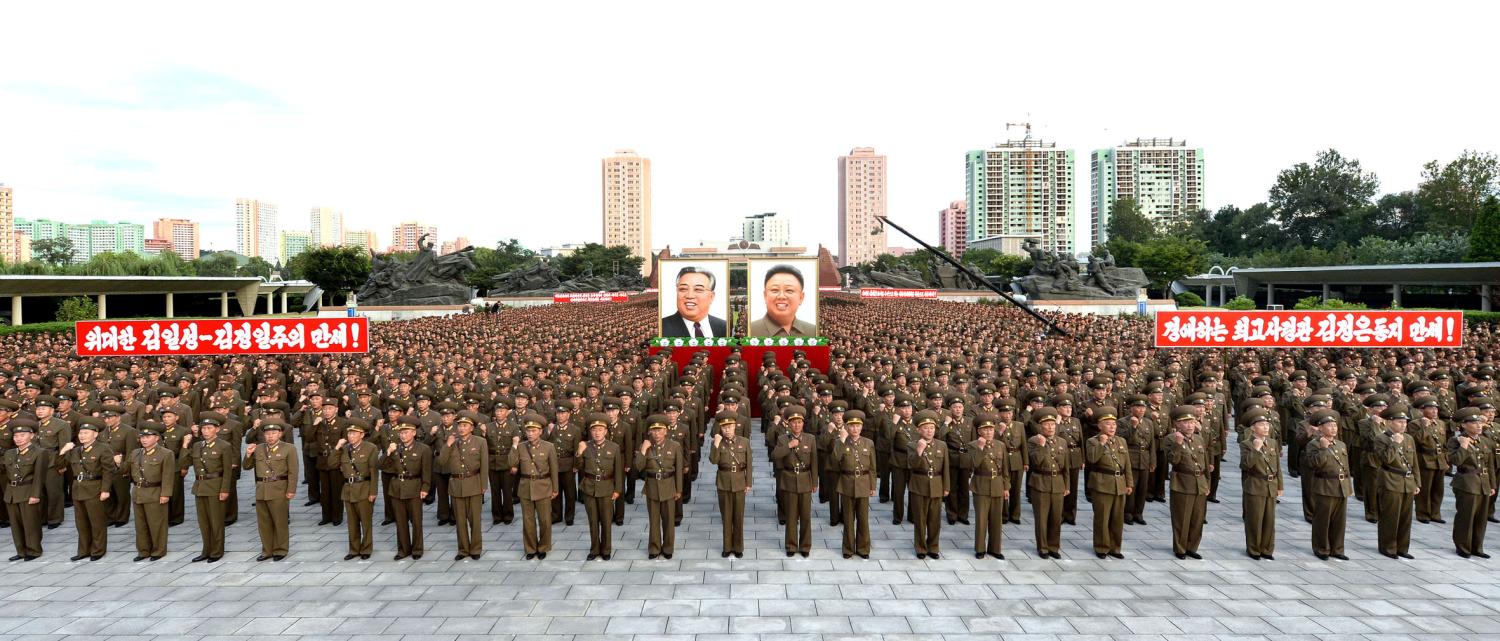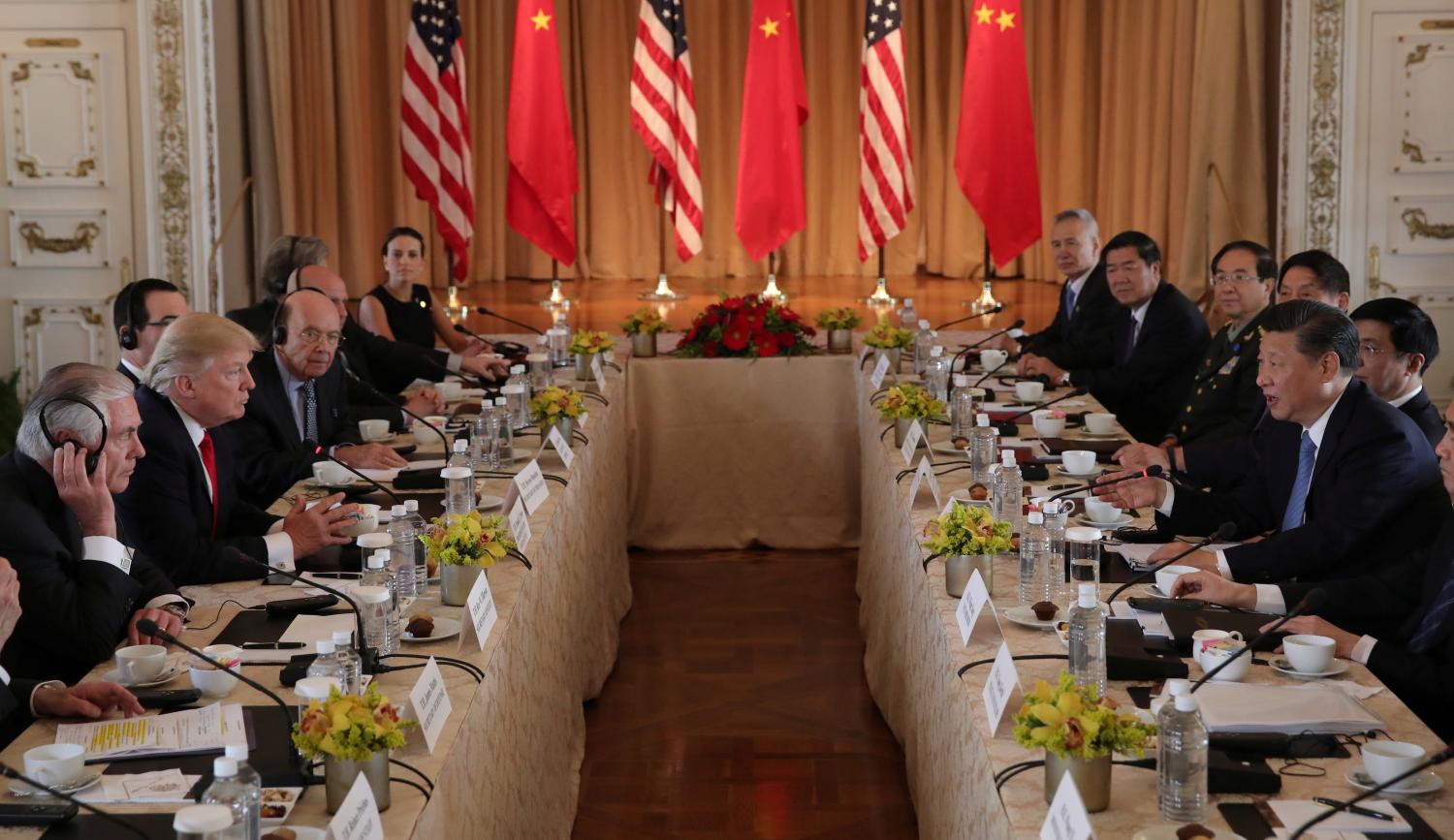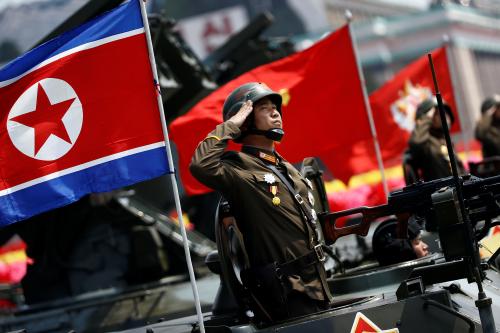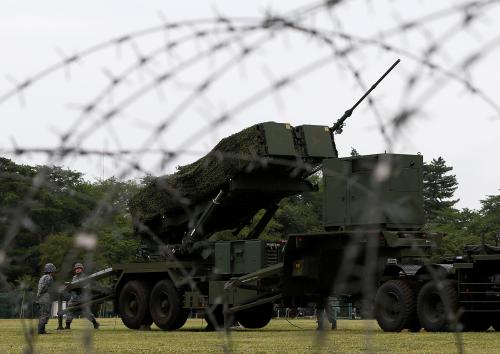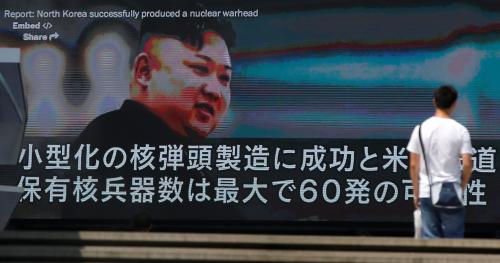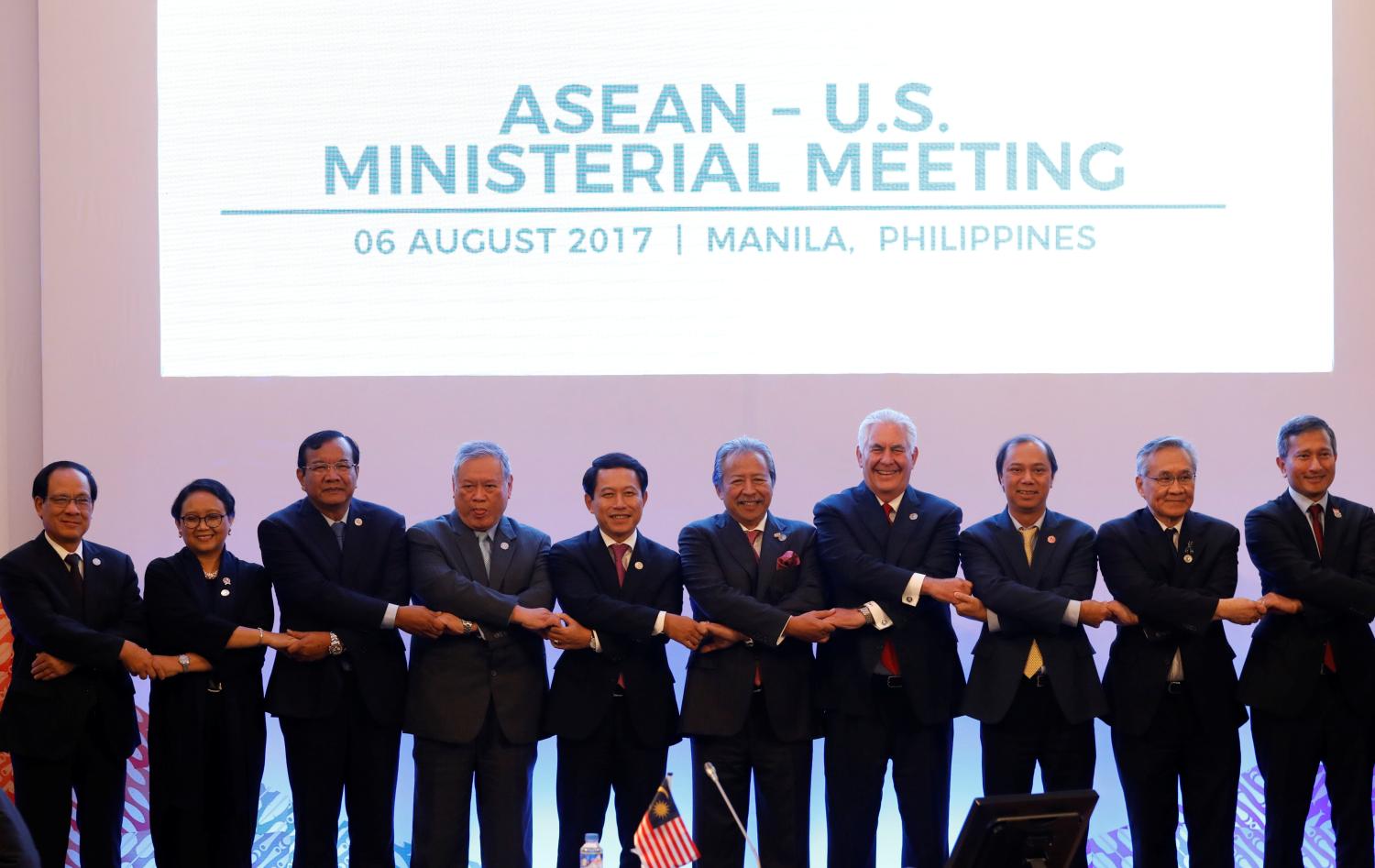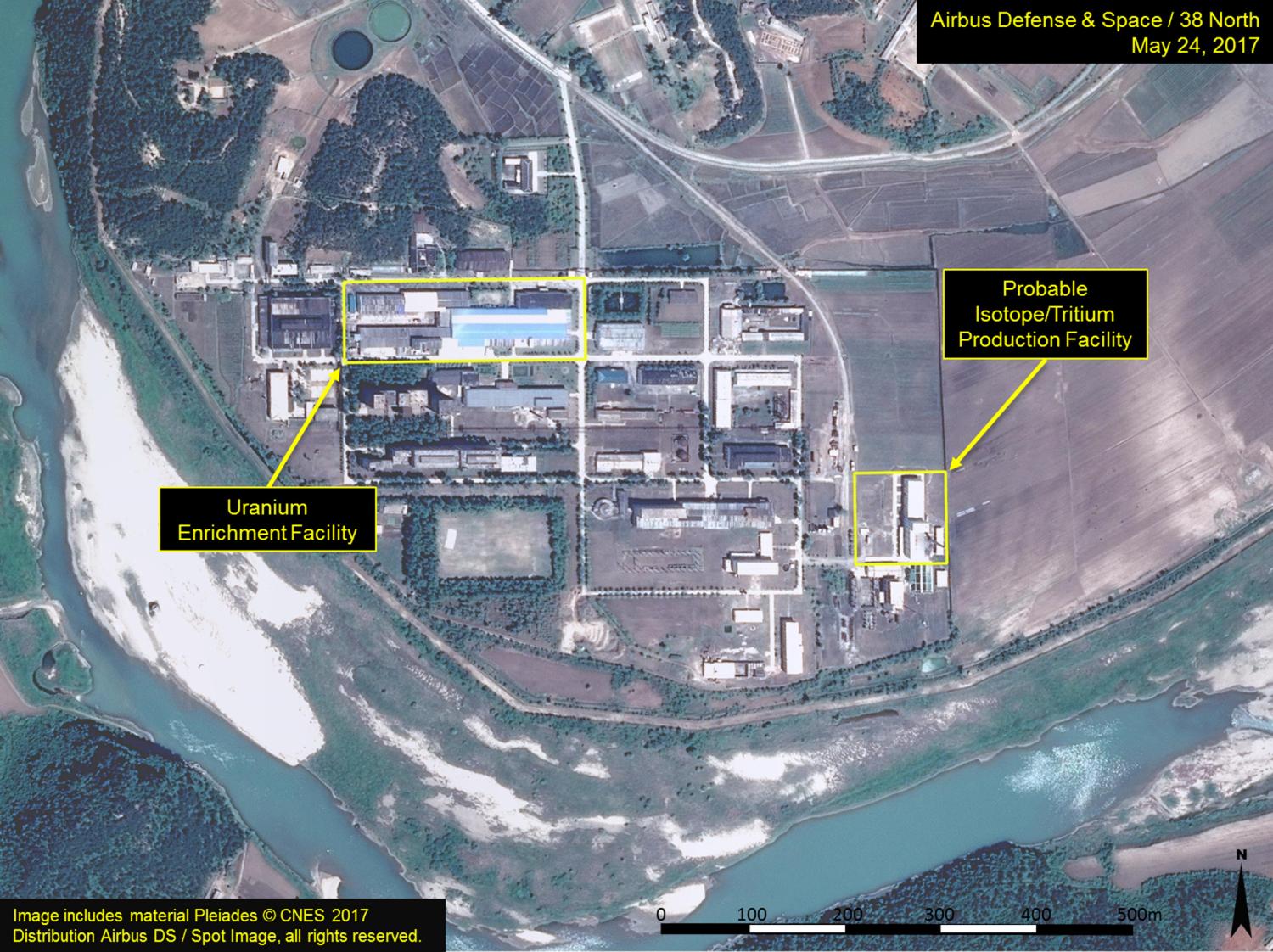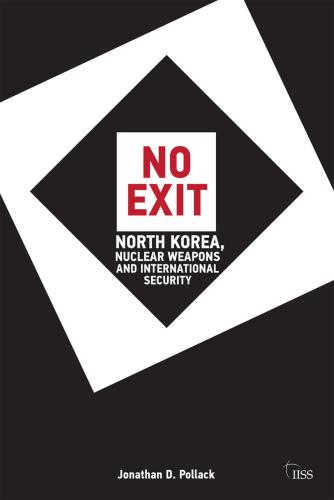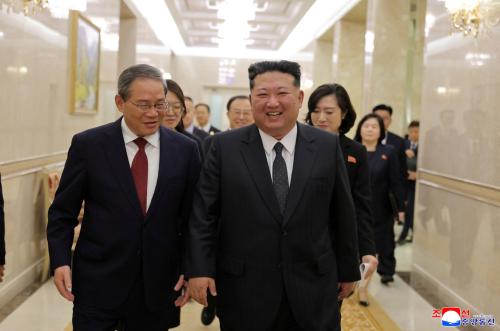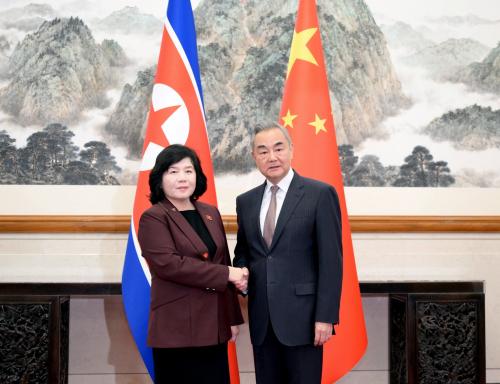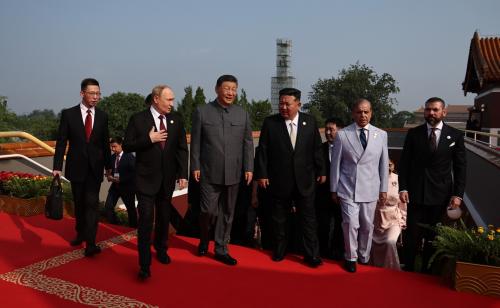With Kim Jong-un once again raising the stakes with the flight test of a second, and more capable, ICBM-range missile—and U.S. intelligence assessing that North Korea can miniaturize nuclear warheads suitable for missile delivery—the United States and its allies must think realistically about possible approaches to addressing the increasingly acute North Korean challenge, adopting a clear-eyed view of which approaches may work and which may not.
The best outcome of the current crisis would be the one the Trump administration is currently pursuing: a decision by North Korea, under irresistible pressure by the United States, China, and others, to abandon its threatening nuclear and missile programs. But such an outcome is very unlikely, and alternatives must be considered, two in particular: first, a negotiated, phased approach to denuclearization starting with interim limits on North Korea’s nuclear and missile capabilities; second, a long-term strategy of pressure, deterrence, and containment.
Complete, near-term denuclearization–a bridge too far
Compelling Pyongyang to give up its programs would depend, at a minimum, on ramping up sanctions and other economic pressures to a level much higher than has been reached to date. Several experts, such as Anthony Ruggiero of the Foundation for the Defense of Democracies, believe this is possible. They identify a variety of opportunities to impose much stronger pressures on Pyongyang but maintain that Washington has failed in recent years to fully exploit such opportunities and that, as a result, a strategy of compelling North Korean restraint through economic and political pressure has not yet been given a true test.
These experts are largely right. The United States has hardly pulled out all the stops in seeking to pressure Pyongyang. That may be changing, as the Trump administration has begun to target Chinese entities for facilitating North Korea’s access to financing and technology for its destabilizing programs. And the United States successfully pressed the U.N. Security Council on August 5 to adopt the strongest sanctions that have so far been put in place, which, if conscientiously enforced, could deprive Pyongyang of roughly $1 billion of export earnings annually. But even if the administration went all-in on a strategy to ramp up pressures decisively and was prepared to go after Chinese entities much more aggressively with secondary sanctions, such a strategy would most likely fall short of forcing the North to disarm.
That is because of two realities recognized by most knowledgeable observers of the North Korea issue. First, although Beijing can probably be persuaded or pressured to do significantly more than it is currently doing to rein in Pyongyang, it will balk at measures that could destabilize the regime. It is noteworthy, in this connection, that, while China voted for the August 5 sanctions resolution, it reportedly succeeded in significantly watering down U.S. proposals for much stronger measures, including restrictions on shipping oil to North Korea.
Second, even if Washington somehow managed to mobilize devastating international pressures against the North, Kim Jong-un would be unwilling to abandon altogether the nuclear deterrent that he considers essential to the survival of his regime. U.S. intelligence agencies have repeatedly assessed that the North’s current leadership is determined to hold onto its strategic capabilities indefinitely—an assessment consistent with North Korean Foreign Minister Ri Yong-ho’s August 7 statement at the ASEAN Regional Forum meeting that his country’s deterrent “is a precious strategic asset that can neither be reversed nor bartered for anything.”

Military force and regime change–also unrealistic
Given these anticipated obstacles to pressuring North Korea to eliminate its nuclear and missile programs altogether, some observers have advocated even more coercive approaches, in particular the use of military force or an active effort to promote regime change. But neither military force nor regime change provides a realistic solution, which Secretary of State Rex Tillerson seemed to acknowledge on August 1, when he told the press that “we do not seek a regime change; we do not seek the collapse of the regime; we do not seek an accelerated reunification of the peninsula; we do not seek an excuse to send our military north of the 38th parallel.”
Although the Pentagon has prepared for a wide range of military contingencies and is ready and able to prevail at any level in a confrontation with North Korea, U.S. military leaders acknowledge that initiating the use of force to deal with the North Korea threat entails intolerable risks, including the prospect of a major war on the Korean Peninsula that could escalate to the nuclear level. And while CIA Director Mike Pompeo may believe that separating Kim Jong-un from his nuclear capabilities is the best way forward, any plan to topple the Kim dynasty, especially in the near term, faces enormous obstacles, not the least of which are Kim Jong-un’s apparently effective efforts to ensure loyalty through rewards and ruthless intimidation as well as China’s determination, notwithstanding its strong opposition to North Korea’s behavior and distain for its leadership, to keep the regime afloat.
A phased approach–a more modest but more realistic option
At various times, Trump administration officials, including the president, have entertained the idea of engaging with North Korea and finding a negotiated solution. At the recent ASEAN Regional Forum meeting in Manila, Secretary Tillerson said: “We hope again that . . . when the conditions are right that we can sit and have a dialogue around the future of North Korea so that they feel secure and prosper economically.” But while such skillful messaging, if backed by strong economic pressures, could succeed in bringing the North to the negotiating table, it would eventually become clear that negotiating a complete, near-term elimination of North Korea’s nuclear capabilities is not in the cards.
The administration should therefore explore whether a more modest outcome—a phased approach to denuclearization, starting with an interim freeze on Pyongyang’s nuclear and missile capabilities—can be achieved on terms that the United States and its allies would consider acceptable.
The first challenge would be to get talks underway. It would be self-defeating to set the bar too high. The North Koreans will not take steps toward denuclearization as a condition for starting negotiations; nor will they agree, in advance, on the goal of the negotiations. At the same time, it would not be acceptable, strategically or politically, for Washington to engage in negotiations while Pyongyang was continuing to advance its programs through further high-profile testing. But rather than require that Pyongyang abstain from testing for some period of time before talks could begin (Secretary Tillerson has publicly conditioned talks on an unspecified period of no missile tests), there should be an explicit understanding among the parties that talks could only begin and continue as long as North Korea refrained from nuclear test explosions and flight tests of long-range missiles. In addition, consideration should be given to allowing talks to begin only if remaining Americans detained by North Korea are released and to continue only as long as no additional Americans are incarcerated.
In exchange for suspending further testing, the North Koreans would almost certainly insist on some sort of U.S. military restraint while talks were underway. They would most likely resurrect their proposal for the suspension of U.S.-South Korean joint military exercises. While it would not be acceptable for the allies to suspend their joint exercises, U.S. and ROK military leaders could consider whether there are adjustments in the scale, character, timing, or location of planned exercises that could be made without compromising training or readiness objectives or alliance cohesion. Any such adjustments would have to be well justified by the security benefits of a North Korean testing suspension and would have to be reversible if Pyongyang decided to break off the talks and resume testing.
Seeking interim limits
With talks underway, the United States and other interested parties (e.g., South Korea, Japan, China, Russia, the European Union)—perhaps through a combination of bilateral and multilateral engagements with the North—could pursue interim limits on DPRK programs. In addition to formalizing the suspension of North Korean nuclear tests and flight tests of long-range missiles (including rocket launches declared to be for civil space purposes), such interim limits would include the suspension of nuclear activities at North Korea’s Yongbyon nuclear complex. Importantly, they would also include the declaration and suspension of all currently covert nuclear activities that the United States and others are convinced are being pursued elsewhere in North Korea, especially enrichment-related activities—an element that would go well beyond the requirements of the 2012 “Leap Day Deal,” which the North Koreans violated within weeks of its conclusion by testing a space launch vehicle ostensibly for civil purposes.
Pyongyang can be expected to strongly resist the declaration and suspension of its clandestine programs outside Yongbyon. But it is hard to imagine the United States agreeing to only a partial suspension of the North’s nuclear activities, knowing that the North could and presumably would continue to produce fissile material for nuclear weapons at undeclared sites if such sites were outside the scope of an agreement.
Credible verification of such a nation-wide suspension would be essential. Monitoring the bans on nuclear and missile testing would be relatively easy, as would monitoring the suspension of nuclear activities at Yongbyon, assuming the International Atomic Energy Agency (IAEA) would be allowed to return to the nuclear complex and implement its full range of safeguards methods there.
Much more difficult would be gaining confidence that the North Koreans had declared and suspended all nuclear activities outside Yongbyon. At a minimum, this would require borrowing extensively from, and rigorously enforcing, the innovative, intrusive verification provisions of the Iran nuclear deal, including routine IAEA access to the full range of uranium fuel cycle facilities, a restrictive procurement channel, and a majority-voting procedure that, in the Iran case, can require Tehran to permit IAEA inspections of sensitive locations or face the prospect of referral to the Security Council and the re-imposition of sanctions. Chinese and Russian support for these verification arrangements in the Iranian context increases the likelihood that Beijing and Moscow would join Washington in pressing for them in an agreement with the DPRK.
An interim agreement would, at least for the time being, allow Pyongyang to keep what it has already acquired: its stocks of fissile material, its fabricated nuclear weapons, and the knowledge and capabilities it has gained from nuclear and missile testing. But to the United States, its allies, and perhaps also to China and Russia, a permanent North Korean nuclear weapons capability is unacceptable, strategically and politically, and so any interim agreement should affirm the goal of complete denuclearization and contain a commitment to continue negotiations toward that end, albeit without an agreed deadline or timeframe, which the North Koreans, at least at the present time, would surely oppose and which, in any event, would be unenforceable.
The North Koreans would undoubtedly insist on some form of “compensation” for accepting limits on its nuclear and missile programs. Their wish list would be overly ambitious, perhaps including the end of U.S.-ROK military exercises, the conclusion of a peace treaty to replace the 1953 Korean War armistice, the termination of sanctions, and even acceptance of the DPRK as a nuclear weapons state. But especially because the interim agreement would only limit and not eliminate North Korean capabilities, such demands would be unacceptable and Pyongyang would have to settle for much less—for example, a commitment not to impose new nuclear- or missile-related sanctions as long as the North abided by the deal, preliminary steps toward replacing the armistice, or an assurance about non-interference in North Korea’s internal affairs.
Pros and cons
An interim agreement along these lines would have several benefits. If effective in halting fissile material production, it would cap the size of North Korea’s nuclear arsenal and the amount of nuclear material potentially available for export. A ban on nuclear test explosions would impede further advances in nuclear warhead miniaturization and reliability. A flight test ban would limit the confidence that North Korea could have in the reliability and accuracy of its missiles.
While it obviously would have been much better to impose these constraints before North Korea made its recent programmatic advances, they would still be of considerable value. In particular, freezing North Korea’s capabilities in key areas would reduce the technical challenges and expenses that the United States and its allies would otherwise face in pursuing military measures capable of deterring and countering DPRK capabilities, especially in fielding missile defenses that could stay ahead of the North Korean missile threat.
Engaging with the DPRK on an interim agreement could also bring benefits outside the nuclear and missile realms. It could provide a somewhat greater window into the intentions and capabilities of that uniquely opaque regime, and it could open channels of communication that could be used to lower tensions, avoid dangerous miscalculations, and perhaps address long-standing concerns, such as the unjustified detention of U.S. citizens.
Moreover, a phased approach starting with an interim agreement is more likely to gain strong Chinese support than insistence on complete, near-term denuclearization, an outcome Beijing probably regards as unachievable. Indeed, the Chinese are more likely to continue ratcheting up economic pressures if they believe such pressures are aimed at achieving a realistic, rather than unattainable, negotiating result. A phased approach is also more likely to ensure U.S.-ROK solidarity, an essential requirement for effectively resolving the North Korea crisis. While President Moon Jae-in is strongly committed to the complete denuclearization of the North, he has expressed support for a phased, incremental path toward that goal.
A phased approach also has significant downsides. There is no guarantee that the North would comply with an interim agreement or that it would not pull out when it decided it needed to resume its programs. While even non-permanent constraints on DPRK capabilities would be of value (because they would buy time for the United States and its allies to strengthen their deterrence and defense capabilities), the inevitable uncertainty over the agreement’s durability would be a serious concern.
Moreover, gaining domestic support for negotiating with a North Korean regime seen by the Congress and American public as untrustworthy and reprehensible would be difficult, especially if any deal were to involve compensation to North Korea that is viewed as unwarranted. And any agreement that limits DPRK capabilities but puts off complete denuclearization to an unspecified future time—even if it effectively arrested the momentum of North Korea’s programs and capped its capabilities at levels significantly lower than would be the case in the absence of an agreement—would inevitably be criticized on the grounds that it provided de facto acceptance of Pyongyang’s nuclear capability and bestowed legitimacy on the North Korean regime.
And while it might be assumed that the North Koreans would be more receptive to a phased approach than an approach requiring them to abandon their programs completely in the near future, they have so far provided no indication that that is the case. Kim Jong-un may well face internal pressures to avoid any limits on DPRK programs on the grounds that they could become a slippery slope to complete denuclearization. The North Koreans have repeatedly and publicly rebuffed the idea of negotiations focused on their nuclear and missile capabilities. This posture could be designed to postpone talks until they have reached certain programmatic milestones; it could be an effort to stake out a strong bargaining position for eventual negotiations; or it could genuinely reflect an unwillingness to consider any limitations on their strategic programs. Only by engaging with North Korea can the United States find out if it is prepared to negotiate seriously and accept meaningful limitations.
Pressure, deterrence, and containment–a long-term strategy
A negotiated, phased approach is clearly far from ideal. But it should not be measured against the much better but exceedingly unlikely outcome of pressuring Pyongyang to agree to completely eliminate its nuclear and missile capabilities at an early date. Instead, the phased approach should be compared to its most plausible and realistic alternative—a long-term strategy of pressure, deterrence, and containment.
Such a strategy would be based on the assumption that completely eliminating North Korea’s strategic programs in the near term—whether through economic pressures, negotiations, military force, or regime change—is not feasible and that a negotiated, phased approach that deferred complete denuclearization to the future is unreliable and, in any event, inadequate. It would also be based on the assumption that the most realistic way of dealing with the DPRK threat is through a policy that, potentially over many years, would deter North Korean aggression, reassure and protect U.S. regional allies, and hopefully result in the eventual elimination of Pyongyang’s threatening strategic capabilities when the Kim dynasty finally collapses or is fundamentally transformed.
Such a long-term strategy would have many of the features of current policy. In particular, the United States would seek to bring maximum pressure to bear on North Korea, including by promoting stronger sanctions and better sanctions enforcement; reducing Pyongyang’s hard currency earnings (e.g., expanding restrictions on imports from North Korea, eliminating or curbing remittances from North Korean overseas laborers); impeding and interdicting the DPRK’s acquisition of materials, equipment, and technology for its nuclear and missile programs; and encouraging China, including with the threat of sanctions against Chinese entities, to stop facilitating North Korea’s illicit efforts. Also like current policy, a long-term strategy would involve working with South Korea and Japan to bolster alliance conventional defense capabilities, including missile defenses, and to ensure the credibility of the U.S. extended nuclear deterrent.
The main difference with the current approach is that these efforts would be aimed not at compelling Pyongyang to agree to abandon its strategic programs in the short run but at deterring and containing North Korea over the longer term, while waiting for, and perhaps more actively promoting, a change of heart or change of regime in Pyongyang.
Such a long-term containment strategy would avoid the uncertainties and political downsides of reaching agreement with the North Koreans, especially an agreement that put off denuclearization to a future time. But it would essentially concede that North Korea could continue to increase the size and technological capabilities of its nuclear and missile forces. And its dismissal of negotiations and its emphasis on maximizing pressures against North Korea for the indefinite future could put the United States at odds with both South Korea and China.
A way forward
Of the various options available to the Trump administration to deal with the North Korean threat, the most realistic are the two described here—a negotiated, phased approach to denuclearization and a long-term policy of pressure, deterrence, and containment. Each offers potential advantages and each involves potential risks.
The most promising way forward would be to treat these two approaches not necessarily as alternatives but as potentially sequential components of a strategy. Indeed, the starting point for such a strategy could be the current Trump administration effort to maximize pressure against North Korea in the hope of getting it to agree to eliminate its threatening capabilities. But if and when negotiating the early and complete denuclearization of North Korea proved unachievable, the administration could shift to pursuing the kind of phased approach recommended here.
Persuading Pyongyang to accept a phased approach on terms that could make it effective and politically palatable would require a continuation of key elements of the Trump administration’s current policy—stronger economic pressures, close coordination among key parties (especially the United States, its Northeast Asian allies, and China), and further efforts by the United States, South Korea, and Japan to strengthen their alliance deterrence and defense capabilities to demonstrate to Pyongyang that continuing to build up its nuclear and missile capabilities will not intimidate the allies and will only leave it less secure.
In the event that a phased approach could not be achieved on acceptable terms—because the North Koreans rejected credible verification arrangements, refused to accept restrictions outside Yongbyon, demanded unrealistic compensation, refused to commit to the eventual goal of complete and verifiable denuclearization, or simply stonewalled against any constraints on their nuclear and missile programs—the effort to negotiate an interim agreement could be abandoned and the focus could shift to a long-term strategy of pressure, deterrence, and containment. In that event, having tried to achieve a negotiated outcome favored by South Korea, China, and other key parties but having failed due to North Korea’s rejection of reasonable terms, the administration would be in a much stronger position to gain the international support needed to sustain such a strategy over the long haul.
None of the options for dealing with North Korea can promise success. That is hardly surprising given that the problem has defied resolution for a quarter century. But any approach that has any chance of succeeding must at least start with a realistic assessment of what may be possible. While making a run at what it considers to be the ideal solution, the Trump administration should give serious consideration to more realistic alternatives.
The Brookings Institution is committed to quality, independence, and impact.
We are supported by a diverse array of funders. In line with our values and policies, each Brookings publication represents the sole views of its author(s).

